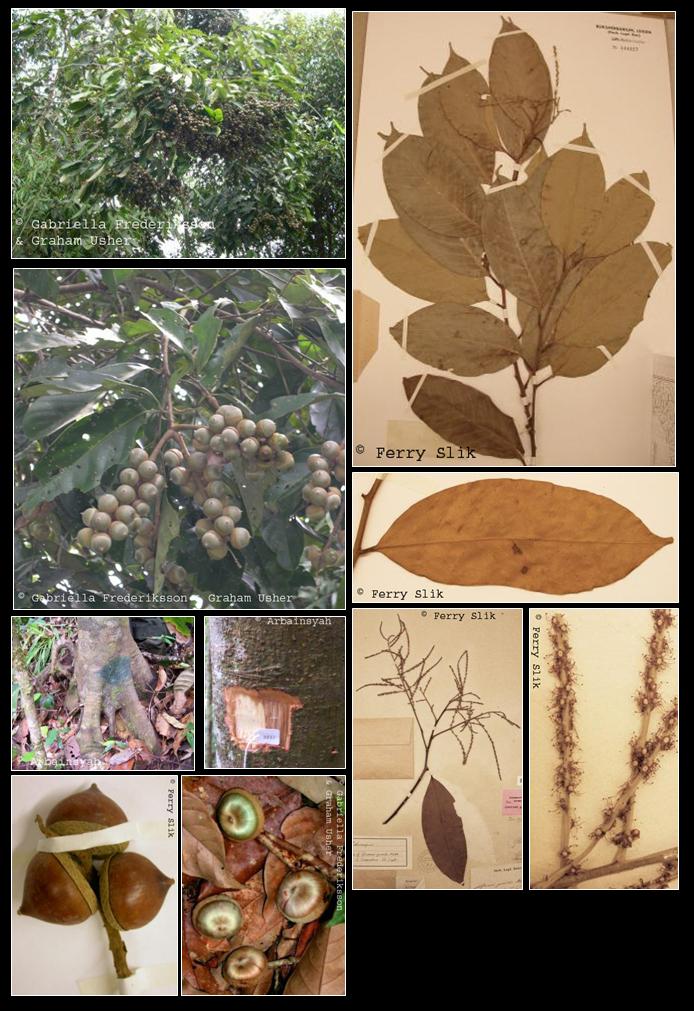Lithocarpus gracilis (Korth.) Soepadmo, Reinwardtia 8 (1970)
Latin for 'narrow or thin', referring to the twigs.Synonyms
Cyclobalanus diepenhorstii (Miq.) Oerst
Cyclobalanus gracilis (Korth.) Oerst
Lithocarpus cyathiformis A.Camus
Lithocarpus cyrtorhyncha (Miq.) Rehd.
Lithocarpus diepenhorstii (Miq.) Barnett
Pasania cyrtorhyncha (Miq.) Gamble
Quercus cyrtorhyncha Miq.
Quercus diepenhorstii Miq.
Quercus gracilis Korth.
Synaedrys cyrtorhyncha (miq.) Koidz
Synaedrys diepenhortsii (Miq.) Koidz
Diagnostics
Mid-canopy tree up to 40 m tall and 90 cm dbh. Stipules ca. 3 mm long.
Leaves alternate, simple, penni-veined, glabrous, venation inconspicuous.
Flowers ca. 3 mm diameter, green-yellow, placed in racemes. Fruits ca. 20 mm
diameter, greenish, nut with basal cupule.
Description
Tree up to 40 m tall, 90 cm diameter; buttresses up to 1.5 m tall. Bark smooth or fissured
or scaly, greyish brown; inner bark fibrous, brownish or yellowish. Sapwood yellowish
brown. Twigs sparsely tomentose, late-glabrescent, sparsely lenticellate or smooth. Stipules
linear, 2-4 x 1 mm. Leaves thin-coriaceous, glabrous above, sparsely brownish appressed
tomentose below; elliptic, oblong or ovate, (8-)12.5-15.5(-18) x (4-)4.5-6.5(-7) cm, base
obtuse to cordate, margin revolute, often undulate, apex bluntly acute to acuminate, acumen
10-15 mm long; midrib faintly raised on both surfaces, stronger below; lateral veins
thin, (12-)13-17(-19) pairs, dense, raised on both surfaces or flat above, faintly joining
near the leaf margin, forming an angle of 30-45(-60) degrees with the midrib; intercostal venation
subscalariform to irregular, dense, obscure above, prominent below; petiole (3-)5-7
(-8) mm long. Inflorescences male, androgynous or mixed. Male inflorescences 10-
20 cm long; bracts narrowly ovate to linear, c. 1.2 x 0.3 mm; bracteoles narrowly ovate,
c. 0.7 x 0.3 mm. Male flowers in clusters of 3-5 along the rachis; perianth lobes obtuse,
c. 0.9 x 0.7 mm; stamen filaments 2-3 mm long; pistillode subglobose, 0.8-1 mm diameter.
Androgynous or mixed inflorescences 12-20 cm long; bracts linear, c. 1.2 x 0.3 mm;
bracteoles narrowly ovate, c. 0.4 x 0.2 mm. Female flowers solitary or in clusters of
3 along the rachis; perianth lobes obtuse, c. 0.6 x 0.3 mm; staminodes 12; styles cylindrical,
straight, 0.7-1 mm long. Cupules solitary, rarely in clusters of 3 along the rachis, sessile
or with stalk c. 5 mm long, saucer- to cup-shaped, 0.5-1 x 1.8-2.5 cm, densely tomentose
with simple hairs, lamellate; wall bony, thin, enclosing less than half of the acorn; lamellae
slightly distinct, edge dentate, set in 6-8 regular lines. Acorns ovoid to conical, 1.5-
1.8(-2) x 1.5-2.5 cm, most part exserted, glabrous, brown; base rounded, apex abruptly
acute; scar shallowly concave or flat, 0.8-1.5 cm diameter; wall bony, thin, most part
free from the cupule. [from Tree Flora of Sabah and Sarawak]
Ecology
In undisturbed mixed dipterocarp, coastal, keranga and sub-montane forests
up to 1700 m altitude. Usually on hillsides and ridges with shallow sandy to
clay soils.
Uses
The wood is locally used for general construction purposes.
Distribution
Peninsular Malaysia, Sumatra, Borneo.
Local names
Borneo: Diparak (Dusun, Banggi), Empeli, Empenit, Empenin, Empili, Mempening, Saled (Kelabit),
Tekaled (Kayan), Tekaled vak (Kenyah), Tikalok (Dusun, Banggi).
